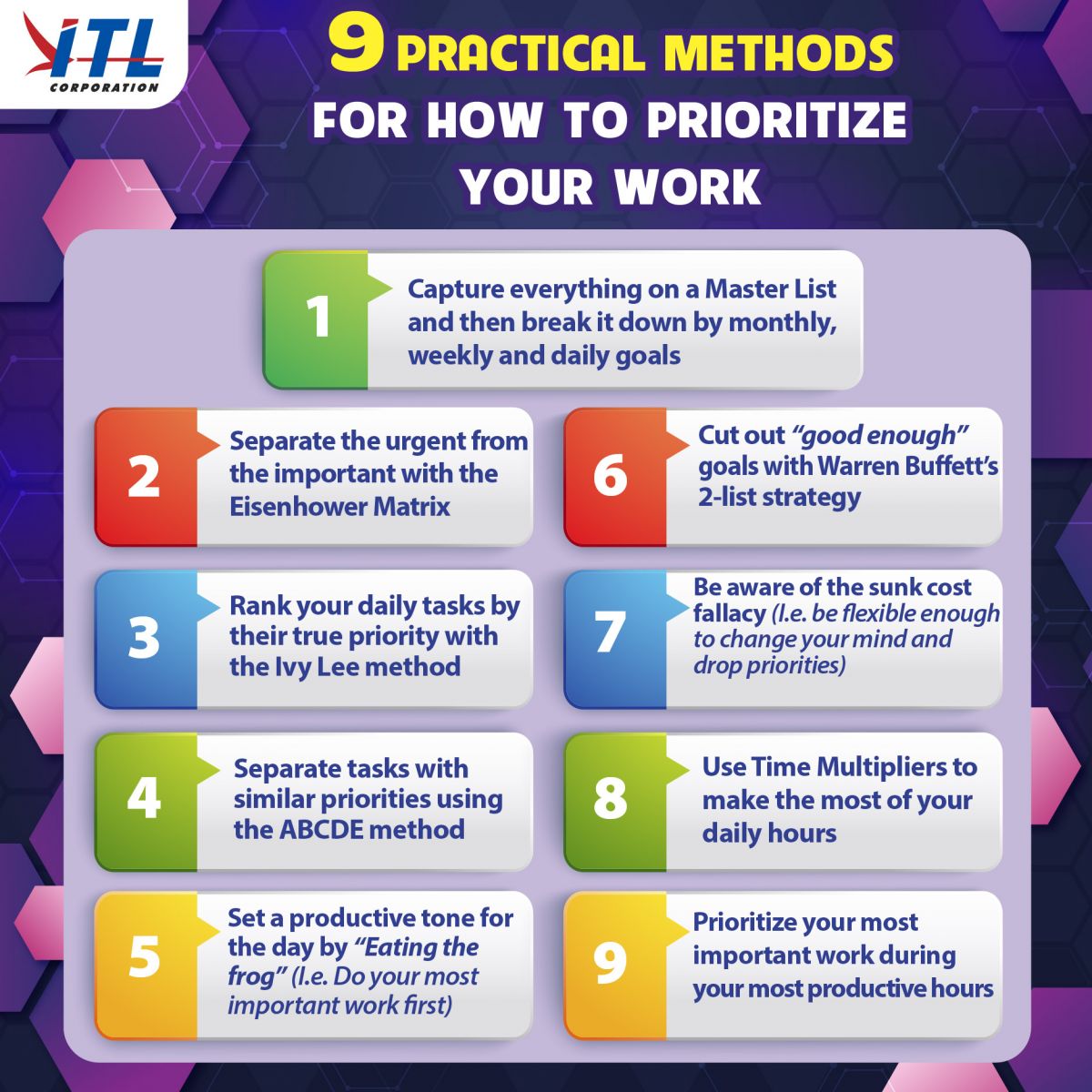18
08/21
9 Practical Methods For How To Prioritize Your Work
Mastering prioritization can change your life. Knowing your priorities reduces stress, helps you focus and ignore FOMO (Fear of Missing Out), can improve productivity and time management, and even help with work-life balance as you create better boundaries for your workday, especially during the working from home period.
Here are the 9 practical methods to help you prioritize your daily tasks, optimize your time, and focus on the work that matters most.

1. Capture everything on a Master List and then break it down by monthly, weekly and daily goals
2. Separate the urgent from the important with the Eisenhower Matrix
· Urgent and important: Do these tasks as soon as possible
· Important, but not urgent: Decide when you’ll do these and schedule it
· Urgent, but not important: Delegate these tasks to someone else
· Neither urgent nor important: Drop these from your schedule as soon as possible
3. Rank your daily tasks by their true priority with the Ivy Lee method
At the end of each work day, write down the six most important things you need to accomplish tomorrow. When you arrive tomorrow, concentrate only on the first task. Work until the first task is finished before moving on to the next one. Approach the rest of your list in the same fashion. At the end of the day, move any unfinished items to a new list of six tasks for the following day. Repeat this process every working day.
4. Separate tasks with similar priorities using the ABCDE method
Here’s how it works: Go through your list and give every task a letter from A to E (A being the highest priority). For every task that has an A, give it a number which dictates the order you’ll do it in. Repeat until all tasks have letters and numbers
5. Set a productive tone for the day by “Eating the frog” (I.e. Do your most important work first) How you start the day sets the tone for the rest of it. And often, getting a large, hairy, yet important task out of the way first thing gives you momentum, inspiration, and energy to keep moving. That’s why a huge number of productivity experts suggest spending time on your most important task (MIT) right away each day
6. Cut out “good enough” goals with Warren Buffett’s 2-list strategy
As the story goes, Buffett ran his personal pilot through this process to help him prioritize his career goals. The first step is to write down your top 25 goals. This could be life goals, career goals, education goals, or anything else you want to spend your time on. Now, circle your top five goals on that list (If you’re doing this right now, finish circling before moving on). Finally, any goal you didn’t circle goes on an “avoid at all cost” list.
7. Be aware of the sunk cost fallacy (I.e. be flexible enough to change your mind and drop priorities)
Humans are especially susceptible to the “sunk cost fallacy” - a psychological effect where we feel compelled to continue doing something just because we’ve already put time and effort into it. But the reality is that no matter what you spend your time doing, you can never get that time back. And any time spent continuing to work towards the wrong priority is just wasted time. Sometimes our effort is better used switching boats than trying to fix a leak.
8. Use Time Multipliers to make the most of your daily hours:
Prioritization isn’t just about tasks. It’s about time as well. Working on the right tasks can either give you more time in the future or take it away from you. Rather than asking: “What’s the most important thing I can do today?”, time multipliers ask: “What’s the most important thing I can do today that would make tomorrow better?
9. Prioritize your most important work during your most productive hours:
Lastly, You can supercharge your productivity by combining your task and time priorities together. We all go through natural highs and lows of energy and focus throughout the day. In other words, there are certain times during the day where you are naturally more productive. If you can find your peak productive times and then schedule your highest priorities during them, you’re setting yourself up for the best day possible.
*Source: nguyenphivan.com/ rescuetime.wpengine.com
Here are the 9 practical methods to help you prioritize your daily tasks, optimize your time, and focus on the work that matters most.

1. Capture everything on a Master List and then break it down by monthly, weekly and daily goals
2. Separate the urgent from the important with the Eisenhower Matrix
· Urgent and important: Do these tasks as soon as possible
· Important, but not urgent: Decide when you’ll do these and schedule it
· Urgent, but not important: Delegate these tasks to someone else
· Neither urgent nor important: Drop these from your schedule as soon as possible
3. Rank your daily tasks by their true priority with the Ivy Lee method
At the end of each work day, write down the six most important things you need to accomplish tomorrow. When you arrive tomorrow, concentrate only on the first task. Work until the first task is finished before moving on to the next one. Approach the rest of your list in the same fashion. At the end of the day, move any unfinished items to a new list of six tasks for the following day. Repeat this process every working day.
4. Separate tasks with similar priorities using the ABCDE method
Here’s how it works: Go through your list and give every task a letter from A to E (A being the highest priority). For every task that has an A, give it a number which dictates the order you’ll do it in. Repeat until all tasks have letters and numbers
5. Set a productive tone for the day by “Eating the frog” (I.e. Do your most important work first) How you start the day sets the tone for the rest of it. And often, getting a large, hairy, yet important task out of the way first thing gives you momentum, inspiration, and energy to keep moving. That’s why a huge number of productivity experts suggest spending time on your most important task (MIT) right away each day
6. Cut out “good enough” goals with Warren Buffett’s 2-list strategy
As the story goes, Buffett ran his personal pilot through this process to help him prioritize his career goals. The first step is to write down your top 25 goals. This could be life goals, career goals, education goals, or anything else you want to spend your time on. Now, circle your top five goals on that list (If you’re doing this right now, finish circling before moving on). Finally, any goal you didn’t circle goes on an “avoid at all cost” list.
7. Be aware of the sunk cost fallacy (I.e. be flexible enough to change your mind and drop priorities)
Humans are especially susceptible to the “sunk cost fallacy” - a psychological effect where we feel compelled to continue doing something just because we’ve already put time and effort into it. But the reality is that no matter what you spend your time doing, you can never get that time back. And any time spent continuing to work towards the wrong priority is just wasted time. Sometimes our effort is better used switching boats than trying to fix a leak.
8. Use Time Multipliers to make the most of your daily hours:
Prioritization isn’t just about tasks. It’s about time as well. Working on the right tasks can either give you more time in the future or take it away from you. Rather than asking: “What’s the most important thing I can do today?”, time multipliers ask: “What’s the most important thing I can do today that would make tomorrow better?
9. Prioritize your most important work during your most productive hours:
Lastly, You can supercharge your productivity by combining your task and time priorities together. We all go through natural highs and lows of energy and focus throughout the day. In other words, there are certain times during the day where you are naturally more productive. If you can find your peak productive times and then schedule your highest priorities during them, you’re setting yourself up for the best day possible.
*Source: nguyenphivan.com/ rescuetime.wpengine.com














